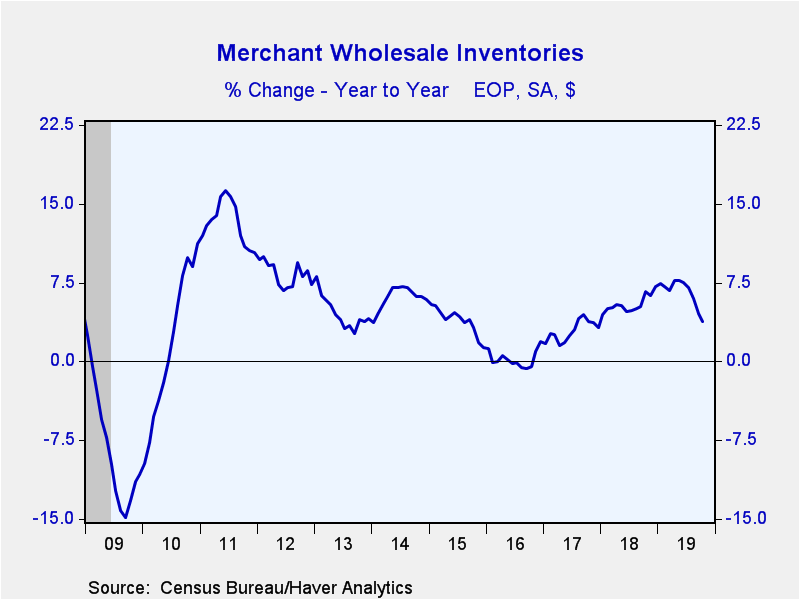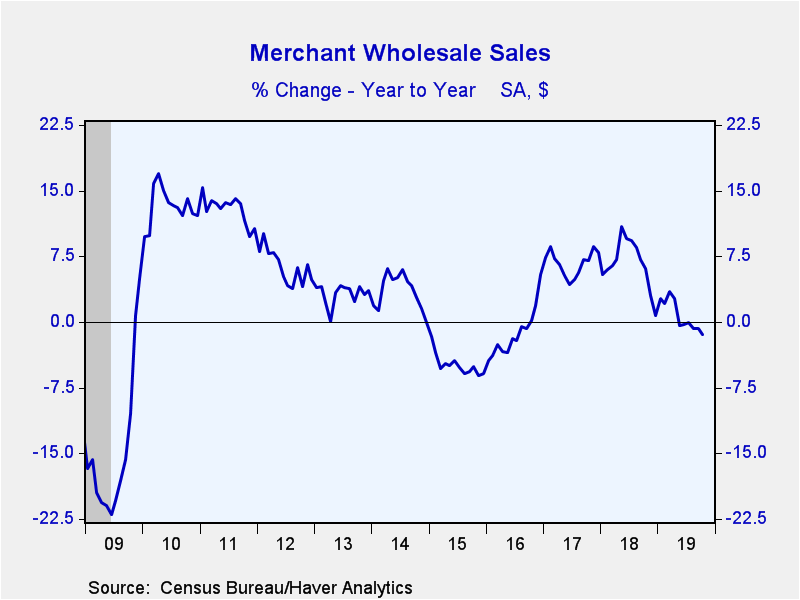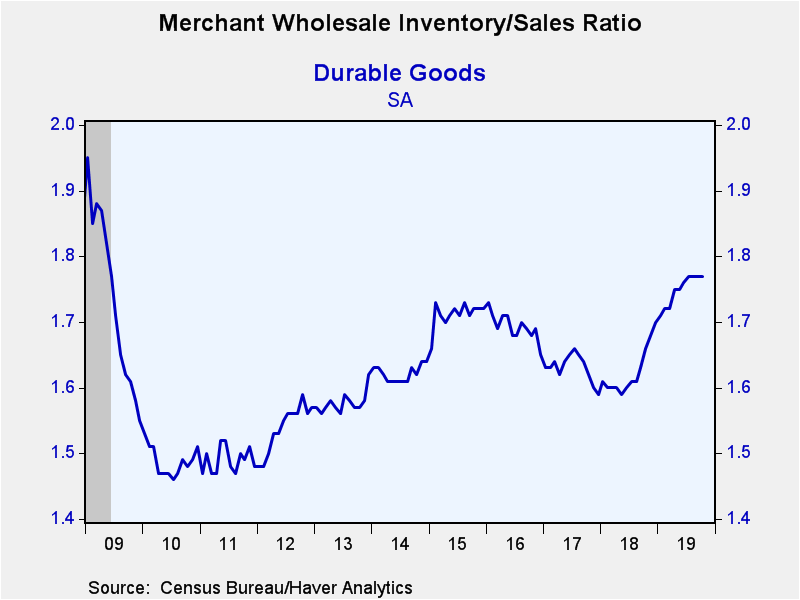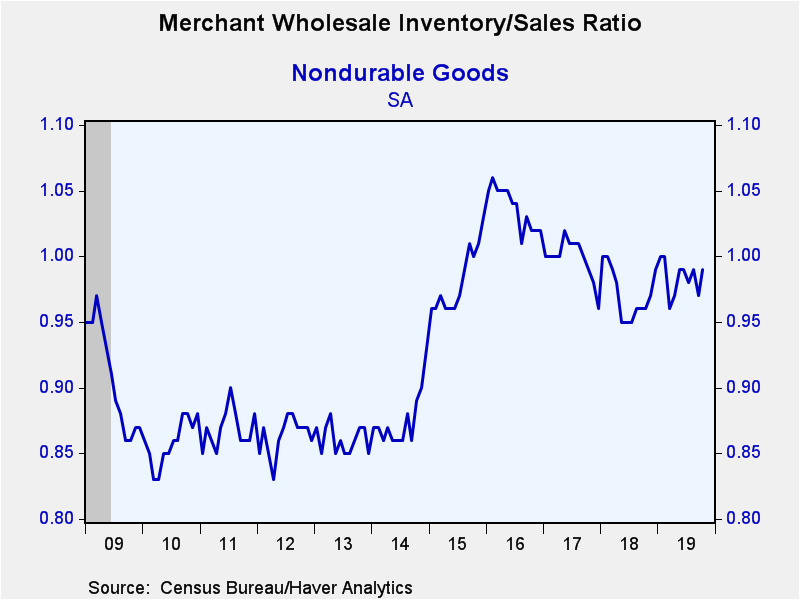 Global| Dec 06 2019
Global| Dec 06 2019U.S. Wholesale Inventories Edge Up While Sales Slump
by:Sandy Batten
|in:Economy in Brief
Summary
Wholesale inventories edged up 0.1% m/m (+3.8% y/y) in October after a downwardly revised 0.7% m/m drop in September (originally -0.4%). The Informa Global Markets Survey had looked for a 0.2% m/m increase. Wholesale sales [...]
Wholesale inventories edged up 0.1% m/m (+3.8% y/y) in October after a downwardly revised 0.7% m/m drop in September (originally -0.4%). The Informa Global Markets Survey had looked for a 0.2% m/m increase. Wholesale sales unexpectedly slumped 0.7% m/m (-1.4% y/y) in October. This was their third consecutive monthly decline. The Action Economics Forecast Survey had expected a 0.2% m/m increase. The inventory-to-sales (I/S) ratio at the wholesale level increased to 1.37 in October from 1.36 in September, the first change in the past five months.
In the details, durable goods inventories eased 0.3% (+4.7% y/y) in October, the same monthly decline as in September. The decline was widely spread across categories with only inventories of electrical and electronic goods (+0.2% m/m) and inventories of hardware and plumbing and heating equipment (+0.4% m/m) posting monthly gains. Machinery inventories, the largest component, were unchanged in October. In contrast, inventories of nondurable goods rose 0.7% m/m (+2.4% y/y) in October, led by a 4.2% m/m jump and inventories of drugs and a 1.7% m/m rise in grocery inventories. Nondurables inventories had fallen 1.3% m/m in September.
Durable goods sales fell 0.6% m/m (-1.9% y/y) in October, their fourth monthly decline in the past five months, with declines widely spread across categories. The largest declines were in metals (-1.6% m/m) and hardware (-1.8% m/m). Nondurable product sales fell 0.9% m/m (-0.8% y/y) in October for their third consecutive monthly decline. Chemical shipments were up 1.9% m/m while shipments of farm products collapsed 10.6% m/m on top of a 7.9% m/m decline in September.
The durable goods I/S ratio was unchanged at 1.77 for the fourth consecutive month, the highest level since 2009. The machinery ratio eased to 2.80 from 2.81, and the motor vehicles I/S ratio receded to 1.78 in October from an expansion high of 1.80 in September. The I/S ratio for nondurable goods rose to 0.99 in October from 0.97. The petroleum industry I/S ratio slipped from 0.35 to 0.33, tying its lowest reading since November 2014.
The wholesale trade figures are available in Haver's USECON database. The expectations figure for inventories is contained in the MMSAMER database. Expectations for sales are in the AS1REPNA database.
| Wholesale Sector - NAICS Classification (%) | Oct | Sep | Aug | Oct Y/Y | 2018 | 2017 | 2016 |
|---|---|---|---|---|---|---|---|
| Inventories | -0.4 | 0.1 | 0.2 | 4.8 | 7.1 | 3.3 | 1.9 |
| Sales | 0.0 | -0.1 | 0.2 | -0.6 | 6.8 | 6.3 | -1.2 |
| I/S Ratio | 1.36 | 1.36 | 1.36 | 1.29 (Sep '18) | 1.29 | 1.30 | 1.35 |
Sandy Batten
AuthorMore in Author Profile »Sandy Batten has more than 30 years of experience analyzing industrial economies and financial markets and a wide range of experience across the financial services sector, government, and academia. Before joining Haver Analytics, Sandy was a Vice President and Senior Economist at Citibank; Senior Credit Market Analyst at CDC Investment Management, Managing Director at Bear Stearns, and Executive Director at JPMorgan. In 2008, Sandy was named the most accurate US forecaster by the National Association for Business Economics. He is a member of the New York Forecasters Club, NABE, and the American Economic Association. Prior to his time in the financial services sector, Sandy was a Research Officer at the Federal Reserve Bank of St. Louis, Senior Staff Economist on the President’s Council of Economic Advisors, Deputy Assistant Secretary for Economic Policy at the US Treasury, and Economist at the International Monetary Fund. Sandy has taught economics at St. Louis University, Denison University, and Muskingun College. He has published numerous peer-reviewed articles in a wide range of academic publications. He has a B.A. in economics from the University of Richmond and a M.A. and Ph.D. in economics from The Ohio State University.










